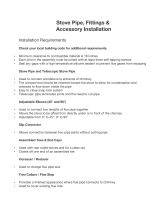Coalbrookdale Darby Installation guide
- Category
- Stoves
- Type
- Installation guide
Coalbrookdale Darby is a versatile stove that provides efficient space heating and hot water for your home. It offers two models: Non-Boiler for direct space heating, and Boiler for heating domestic hot water and radiators. The Darby stove is designed for optimal performance, delivering up to 16.1kW of direct space heating with smokeless fuel and 12.3kW of water heating with either smokeless fuel or coal. It boasts a large room heating capacity, capable of warming up to 247.5 cubic meters (8800 cubic feet) of space, making it ideal for medium to large-sized rooms.
Coalbrookdale Darby is a versatile stove that provides efficient space heating and hot water for your home. It offers two models: Non-Boiler for direct space heating, and Boiler for heating domestic hot water and radiators. The Darby stove is designed for optimal performance, delivering up to 16.1kW of direct space heating with smokeless fuel and 12.3kW of water heating with either smokeless fuel or coal. It boasts a large room heating capacity, capable of warming up to 247.5 cubic meters (8800 cubic feet) of space, making it ideal for medium to large-sized rooms.










-
 1
1
-
 2
2
-
 3
3
-
 4
4
-
 5
5
-
 6
6
-
 7
7
-
 8
8
-
 9
9
-
 10
10
Coalbrookdale Darby Installation guide
- Category
- Stoves
- Type
- Installation guide
Coalbrookdale Darby is a versatile stove that provides efficient space heating and hot water for your home. It offers two models: Non-Boiler for direct space heating, and Boiler for heating domestic hot water and radiators. The Darby stove is designed for optimal performance, delivering up to 16.1kW of direct space heating with smokeless fuel and 12.3kW of water heating with either smokeless fuel or coal. It boasts a large room heating capacity, capable of warming up to 247.5 cubic meters (8800 cubic feet) of space, making it ideal for medium to large-sized rooms.
Ask a question and I''ll find the answer in the document
Finding information in a document is now easier with AI
Related papers
-
AGA Coalbrookdale Darby installation Guide Owner's manual
-
AGA Severn Boiler Installation guide
-
AGA Little Wenlock 3 Owner's manual
-
AGA Coalbrookdale Much Wenlock boiler installation Guide Owner's manual
-
AGA Darby User guide
-
AGA Coalbrookdale Little Wenlock MK2 Installation guide
-
AGA Severn Boiler Owner's manual
-
AGA MUCH WENLOCK NON- BOILER Owner's manual
-
AGA Coalbrookdale Severn non boiler installation guide Owner's manual
-
AGA Much Wenlock non boiler Owner's manual
Other documents
-
 Speedi-Products SP-BC 06 Operating instructions
Speedi-Products SP-BC 06 Operating instructions
-
AGA Rayburn ECO-CONNECT PLUMBING SYSTEM User guide
-
Rayburn 300W Installation Instructions Manual
-
AGA Georgian room heater Installation guide
-
AGA Rembrandt Owner's manual
-
Rayburn Heatranger 216SFW Installation Instructions Manual
-
Aeg-Electrolux FM2500DD-A User manual
-
AEG FM2500DD-A User manual
-
AGA Rayburn 216M User guide
-
Aeg-Electrolux FM2500DD-A User manual










